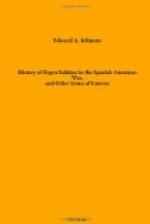To a Massachusetts soldier in another group of interviewers, the same question was put: “How about the colored soldiers?”
“They fought like demons,” came the answer.
“Before El Caney was taken the Spaniards were on the heights of San Juan with heavy guns. All along our line an assault was made and the enemy was holding us off with terrible effect. From their blockhouse on the hill came a magazine of shot. Shrapnell shells fell in our ranks, doing great damage. Something had to be done or the day would have been lost. The Ninth and part of the Tenth Cavalry moved across into a thicket near by. The Spaniards rained shot upon them. They collected and like a flash swept across the plains and charged up the hill. The enemy’s guns were used with deadly effect. On and on they went, charging with the fury of madness. The blockhouse was captured, the enemy fled and we went into El Caney.”
In another group a trooper from an Illinois regiment was explaining the character of the country and the effect of the daily rains upon the troops. Said he:
“Very few colored troops are sick. They stood the climate better and even thrived on the severity of army life.”
Said he: “I never had much use for a ‘nigger’ and didn’t want him in the fight. He is all right, though. He makes a good soldier and deserves great credit.”
Another comrade near by related the story as told by a cavalry lieutenant, who with a party reconnoitered a distance from camp. The thick growth of grass and vines made ambuscading a favorite pastime with the Spaniards. With smokeless powder they lay concealed in the grass. As the party rode along the sharp eye of a colored cavalryman noticed the movement of grass ahead. Leaning over his horse with sword in hand he plucked up an enemy whose gun was levelled at the officer. The Spaniard was killed by the Negro who himself fell dead, shot by another. He had saved the life of his lieutenant and lost his own.
A comrade of the Seventeenth Infantry gave his testimony. Said he:
“I shall never forget the 1st of July. At one time in the engagement of that day the Twenty-first Infantry had faced a superior force of Spaniards and were almost completely surrounded. The Twenty-fourth Infantry, of colored troops, seeing the perilous position of the Twenty-first, rushed to the rescue, charged and routed the enemy, thereby saving the ill-fated regiment.”
Col. Joseph Haskett, of the Seventeenth regular Infantry, testifies to the meritorious conduct of the Negro troops. Said he:
“Our colored soldiers are 100 percent superior to the Cuban. He is a good scout, brave soldier, and not only that, but is everywhere to be seen building roads for the movement of heavy guns.”
Among the trophies of war brought to Old Point were a machete, the captured property of a colored trooper, a fine Spanish sword, taken from an officer and a little Cuban lad about nine years old, whose parents had bled for Cuba. His language and appearance made him the cynosure of all eyes. He was dressed in a little United States uniform and had pinned to his clothing a tag which read: “Santiago buck, care of Col. C.L. Wilson, Manhattan Club, New York.” His name is Vairrames y Pillero.




